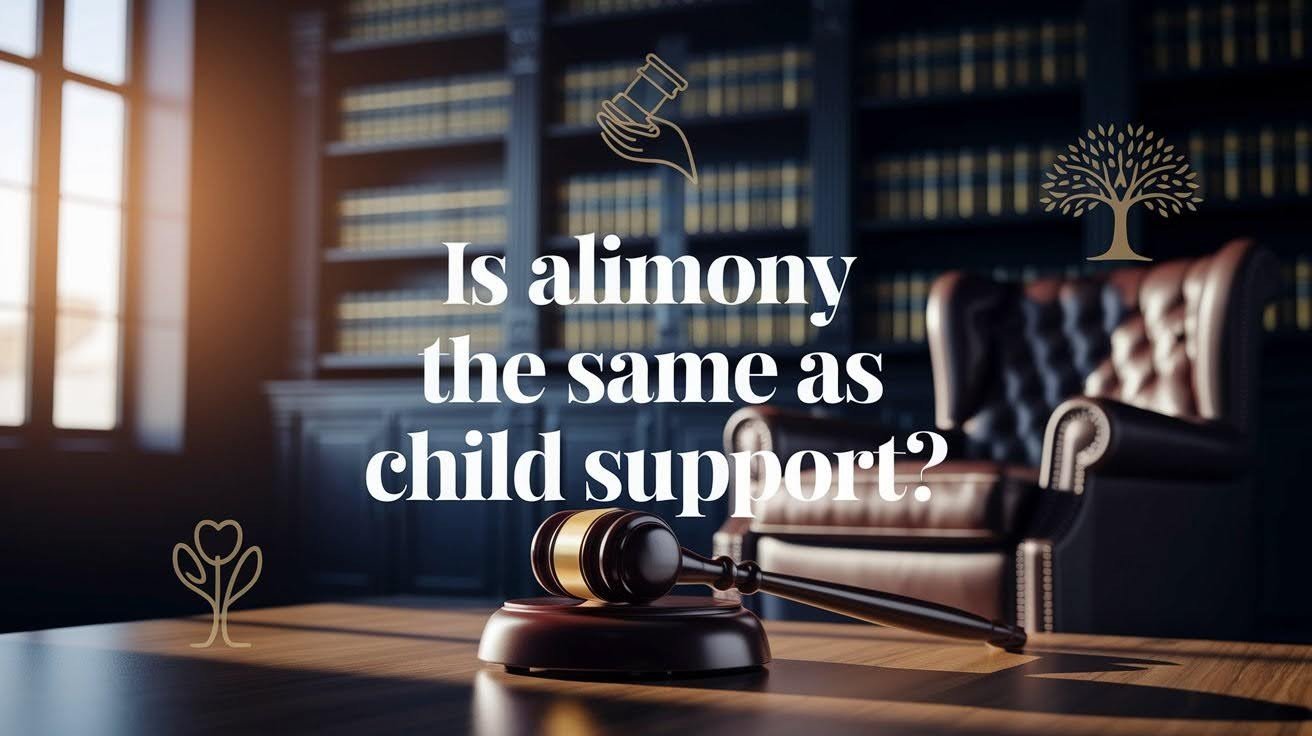Divorce can bring various types of problems, and these include financial problems that can be overwhelming. A couple usually thinks about payments following a split. They ponder various forms of payment for giving or getting. Is alimony equal to child support?
In order to answer this question, the answer here is: No, alimony does not equal child support. The payments are different, and they serve purposes that differ.
It is very important for anyone going through a divorce to understand the concepts. Grasping distinctions matters a great deal, too. This blog is going to help you understand both types of support, learn how they work, and learn their differences.
The Main Answer: Two Different Types of Support
Alimony and child support are two distinct types of financial support, each serving different purposes: one for former spouses, the other for children.
| Aspect | Alimony | Child Support |
| Purpose | Provides financial help to former spouses after divorce. | Ensures children have what they need to live well. |
| Coverage | Helps the lower-earning spouse maintain a similar lifestyle after marriage. | Covers basic needs like food, clothing, housing, and medical care. |
| Requirement | Not required in every divorce; it depends on the court decision. | Mandatory when parents have minor children. |
| Legal Focus | Protects adults and their post-divorce standard of living. | Protects children and ensures their well-being. |
What is Alimony?
Alimony is a legal obligation where one spouse provides financial support to the other after a divorce or separation. It is designed to help the lower-earning or non-earning spouse maintain a standard of living similar to what they had during the marriage.
The amount and duration of alimony depend on factors like the length of the marriage, each spouse’s income and earning capacity, and their contributions to the household or career development. Courts often consider the needs and financial stability of both parties before deciding.
Definition and Main Purpose
Also called spousal support or maintenance, alimony is money one ex-spouse pays to the other. Courts may order this payment when one spouse earns much less money than the other spouse.
Financial support helps the lower-earning spouse maintain a reasonable standard of living. This support recognizes that some people may have given up careers or education to support their family during marriage.
The goal is to prevent unfair hardship after divorce. Alimony gives the receiving spouse time to become financially independent or helps them if they cannot work due to age or health problems.
Types of Alimony
Temporary alimony: provides short-term help during divorce proceedings. This support helps cover basic expenses while the legal process continues and ends when the divorce is final.
Rehabilitative alimony: helps a spouse get job training or education. This type of support has a time limit and ends when the person can support themselves through work.
Lump-sum alimony: involves one large payment instead of monthly payments. Permanent alimony continues for a long time or until the receiving spouse remarries or either spouse dies.
Key Features of Alimony
Not guaranteed in all divorces, alimony depends on specific circumstances. Courts look at factors like marriage length, each spouse’s income, and their ability to work.
Courts consider many factors before ordering alimony payments. These include the standard of living during marriage, each person’s health, and their contributions to the marriage.
Payments can be changed or stopped when circumstances change significantly. Life events like job loss, illness, or remarriage may affect alimony orders.
What is Child Support?
Child support is a legal financial obligation that one parent pays to the other to help cover the costs of raising their child after a separation or divorce. It ensures that the child’s basic needs, such as food, clothing, education, and healthcare, are met.
The amount of child support is usually determined by the parents’ incomes, the child’s needs, and the amount of time each parent spends with the child. Courts often use standard guidelines to calculate a fair amount.
Definition and Main Purpose
Financial obligation covers children’s needs and helps maintain their quality of life. Both parents must support their children financially, even when they live in separate homes.
Money covers basic needs and expenses like housing, food, clothing, healthcare, and education costs. Child support helps children maintain stability during and after their parents’ divorce.
The goal is to protect children’s standard of living and ensure they have what they need to grow and thrive. This support continues the financial responsibility that parents had during marriage.
Key Features of Child Support
Required in divorces with minor children, child support is not optional. Courts will order these payments in almost every case where parents divorce and have children under 18.
Calculated using state guidelines and formulas that consider specific factors. These formulas help ensure fair and consistent support amounts across similar cases in each state.
Continues until children reach adult age, typically 18 or when they graduate high school. Some states extend support through college or for children with special needs.
Key Differences Between Alimony and Child Support
Understanding these differences helps families plan better and know what to expect during divorce proceedings.
| Aspect | Alimony | Child Support |
| Who Receives the Money | Former spouse who needs financial help after divorce; used for personal living expenses. | Children benefit directly through the custodial parent; it must be used for the children’s expenses. |
| Purpose | Helps adults adjust to life after divorce. | Ensures children’s needs are met. |
| Requirements And Eligibility | Discretionary; courts consider factors like income differences and marriage contributions. May not be awarded even if one spouse earns much more. | Mandatory when parents have minor children; courts always order it unless both parents have equal custody and identical incomes. |
| Payment Duration | Varies from temporary (months) to permanent (years); it depends on marriage length and the recipient’s ability to become self-supporting. | Lasts until children reach majority or graduate high school; some states extend through college or for children with disabilities. |
| Effect of Life Events | Remarriage typically ends alimony. | Life events like remarriage do not affect child support obligations. |
| How Amounts are Determined | Judicial discretion considers lifestyle during marriage, each spouse’s income potential, and contributions. | Follows state guidelines with formulas based on parents’ incomes, number of children, and custody arrangements. |
| Consistency | Amounts vary widely based on individual circumstances. | Amounts are more predictable due to formulas. |
Legal and Financial Effects
These support types have different legal treatments and tax implications that affect both payers and receivers.
Tax Treatment After 2019 Changes
Alimony is no longer tax-deductible for the paying spouse under current federal tax law. The receiving spouse also does not pay income tax on alimony payments received.
Child support is never taxable or deductible for either parent. These payments do not affect tax returns for the payer or receiver in any way.
The 2019 tax law changes made alimony treatment similar to child support. This change affects how courts and couples approach alimony decisions in divorce settlements.
Prenuptial Agreements
Alimony can be addressed in prenups with couples agreeing to waive or limit spousal support. These agreements help couples plan for potential divorce and avoid future disputes.
Child support cannot be waived in prenuptial agreements because children’s rights cannot be signed away before they are born. Courts will not enforce prenup provisions that limit child support.
Different legal protections exist for these support types. The law prioritizes children’s welfare over adult agreements that might limit their financial support.
Negotiation and Legal Considerations
Understanding your options helps you make better decisions during divorce proceedings and afterwards.
Can You Receive Both at the Same Time?
Yes, you can receive both types of support because they serve different purposes. Many divorced people receive child support for their children and alimony for their own needs.
Child support typically gets priority when courts make decisions about available income. Courts ensure children’s needs are met before considering spousal support requests.
The combination depends on circumstances like income levels, custody arrangements, and marriage length. People often wonder if alimony is the same as child support, but receiving both shows they clearly serve different needs.
When to Get Legal Help?
Complex financial situations require professional legal advice. High-income couples, business owners, and people with complicated assets need lawyers who understand family law.
State-specific laws vary significantly for both types of support. What works in one state may not apply in another, making local legal knowledge essential.
Early legal consultation helps you understand your rights and obligations. Getting advice before agreeing to anything protects your interests and your children’s welfare.
Tips for Managing Alimony and Child Support
Proper management of alimony and child support ensures financial stability and reduces stress for both you and your family:
- Keep detailed financial records: of all support payments made and received. This documentation helps with taxes, modifications, and enforcement issues.
- Use official payment methods: like certified checks or electronic transfers that create clear records. Avoid cash payments that are hard to prove later.
- Understand your state’s specific laws: because support rules vary significantly between states. Research local guidelines or consult with attorneys familiar with your area.
- Plan for the tax implications: of both types of support. Child support has no tax effects, but alimony rules changed in 2019 for new agreements.
- Communicate changes promptly: to courts and ex-spouses when your financial situation changes. Early communication prevents bigger problems later.
- Budget carefully: for support payments in your monthly expenses. These obligations are legally required and must be prioritized in your spending plan.
- Review agreements regularly: to ensure they still meet everyone’s needs as children grow and circumstances change over time.
- Seek modification when appropriate: rather than simply stopping payments. Courts can only change orders through proper legal procedures.
- Consider life insurance: to protect support payments if something happens to the paying spouse. This protection benefits both children and former spouses.
- Keep copies of all court orders: and legal documents related to support. You may need these papers for various purposes over the years.
- Work with qualified professionals: including lawyers, accountants, and financial planners who understand family law and support obligations.
Conclusion
“Is alimony the same as child support?” now has a clear answer: distinct purposes define them as two different types of financial support. Alimony can offer some monetary aid to previous partners. Child support guarantees that children’s needs are satisfied now. Understanding these differences matters after divorce.
Child support is mandatory in instances when parents have minor children, according to specific state guidelines for its calculation. Alimony is discretionary, with the court making this decision. Income and marriage length, as well as financial needs, are all factors influencing this decision.
Those rules also enforce taxes, along with lasting for different durations between the two. If you are navigating divorce or have a need to adjust support orders, at the time you consult a qualified family law attorney, this ensures that your rights are protected and your family’s future is secure.
Frequently Asked Questions
Can I receive both alimony and child support at the same time?
Yes, you can receive both types of support simultaneously because they serve different purposes – one supports you as a former spouse, while the other supports your children’s needs.
How long does each type of support typically last?
Child support usually continues until children reach 18 or graduate from high school. Alimony duration varies widely from temporary payments lasting months to permanent support lasting years, depending on circumstances.
Are the tax treatments different for alimony and child support?
Yes, current tax law treats them differently. Child support is never taxable or deductible. Alimony is not tax-deductible for payers or taxable for receivers under current rules.
Can prenuptial agreements limit both types of support?
Prenups can address alimony, but cannot limit child support. Courts will not enforce agreements that restrict children’s right to financial support from both parents, regardless of prenuptial agreements.
What happens if someone stops paying either type of support?
Both types face enforcement actions, but child support enforcement is typically more aggressive. Consequences can include wage garnishment, license suspension, property seizure, and even jail time for non-payment.







